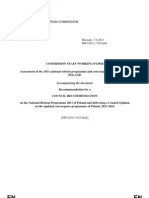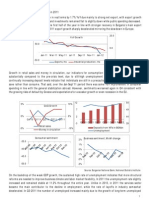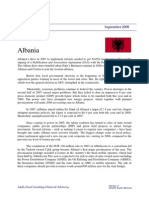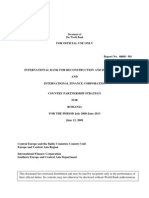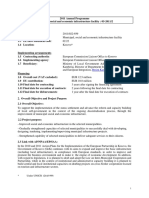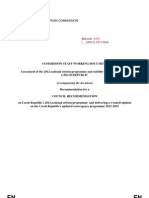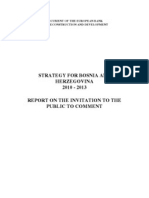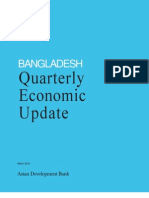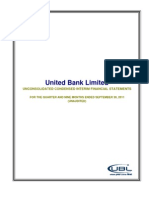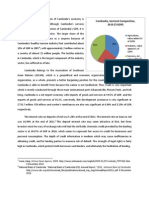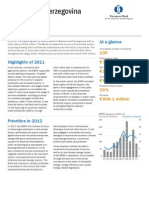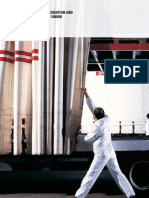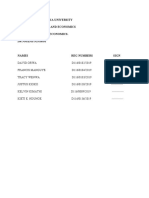Bosnia
Bosnia
Uploaded by
api-198396065Copyright:
Available Formats
Bosnia
Bosnia
Uploaded by
api-198396065Original Title
Copyright
Available Formats
Share this document
Did you find this document useful?
Is this content inappropriate?
Copyright:
Available Formats
Bosnia
Bosnia
Uploaded by
api-198396065Copyright:
Available Formats
102
COUNTRY ASSESSMENTS Transition Report 2012
BOSNIA AND HERZEGOVINA
HIGHLIGHTS OF THE PAST YEAR
Economic growth has been weak but some progress has been made on policies. Only minimal growth has been recorded over the past year. Following the nalisation of the state and entity budgets, progress was made towards re-engaging with the IMF, culminating in the signing of a new programme. Private sector involvement in the road sector is advancing. A tender for a public-private partnership (PPP) in the transport sector based on best international practice has been announced for a concession of a section of a key international transport corridor in Republika Srpska. Non-performing loans (NPLs) are rising in the banking sector, but liquidity remains sound. The level of NPLs still remains below that of some regional peers and the direct impact of the international nancial crisis on the local banking sector has been limited so far.
MACROECONOMIC PERFORMANCE Weak domestic demand, an unfavourable external environment and political stalemate have held back economic recovery. Following a year of anaemic growth in 2010, the economy showed some signs of revival in early 2011. However, weaker growth in the eurozone has negatively aected Bosnia and Herzegovinas exporting activity and capital inows in the second half of the year and the beginning of 2012. Exports fell by 8.6 per cent between Q2 and Q4 of 2011. At the same time, domestic consumption has remained subdued, largely owing to the austerity measures implemented by the authorities in the past two years as well as the weakened contribution from remittances, which are signicantly below pre-crisis levels. As a result, overall growth in 2011 was a modest 1.3 per cent. Ination remains low. The disinationary pressures that dominated much of the post-crisis period were reversed for a brief interval in early 2012, but ination has been on a generally downward path since, and it stood at 1.8 per cent in August 2012. A new Stand-By Arrangement (SBA) with the IMF was approved in September 2012. The 24-month US$ 520.6 million SBA will provide a buer against external shocks from the ongoing eurozone crisis as well as an anchor for important structural reforms envisioned in the country's 2012-14 economic programme. The new arrangement follows the expiration of a 36-month SBA, which was put on hold in 2011 due to the political stalemate that left the country without a central government for over 15 months after the October 2010 elections. The authorities are planning a budget decit of 3 per cent of projected GDP in 2012. The economic programme envisages continued scal consolidation accompanied by structural scal reforms to safeguard medium-term scal sustainability. The economic outlook for 2012 and 2013 remains bleak. The weak external and domestic environment will constrain growth in Bosnia and Herzegovina this year and beyond. GDP growth is forecast at close to zero per cent in 2012 and only slightly higher in 2013. The economy remains vulnerable on many fronts, not only because the whole region is struggling but also because the internal complexity of the countrys political structure and the poor investment climate are major deterrents to investment.
KEY PRIORITIES FOR 2013
Further progress is needed on EU approximation. Bosnia and Herzegovina is the only SEE country that has not yet submitted an application for EU membership. Key priorities include political reforms, boosting competitiveness, reforming the social benets system and improving the countrys infrastructure. Some basic investment climate reforms should be introduced. The countrys persistently low scores on many cross-country indicators suggest there is a lack of consensus on the need for deep economic reforms, as well as plenty of scope for improvements in areas such as licences and permits, and enforcement of contracts. Major reforms are needed in the energy sector. Bosnia and Herzegovina has signicant potential in renewables, but the legal and institutional framework for sustainable energy remains weak.
Main macroeconomic indicators (% unless indicated)
2009 GDP growth Ination (end-year) Government balance/GDP Current account balance/GDP Net FDI (in million US$) External debt/GDP Gross reserves/GDP Credit to private sector/GDP -2.9 0.0 -5.9 -6.3 245 55.8 19.0 54.4 2010 0.7 3.1 -3.9 -5.7 188 52.3 20.5 63.8 2011 estimated 1.3 2.7 -3.1 -8.8 416 46.5 19.9 55.1 2012 projected 0.1 1.7 -2.8 -8.0 253 na na na
2012 sector transition indicators
Sector transition score
4.0 3.5 3.0 2.5 2.0 Sustainable energy Natural resources 1.5 General industry Agribusiness Real estate 1.0 0.5 0.0 Telecommunications
Capital markets
Urban transport
Corporate
Energy
Infrastructure
FI
Source: EBRD. Note: Water Water and wastewater; IAOFS Insurance and other nancial services; PE Private equity.
MSME nance
Electric power
Railways
Banking
Roads
IAOFS
Water
PE
COUNTRY ASSESSMENTS Bosnia and Herzegovina
103
MAJOR STRUCTURAL REFORM DEVELOPMENTS Limited progress has been made on EU approximation over the past year. In its annual Progress Report published in October 2012, the European Commission (EC) once again urged the country to make greater headway on economic and structural reforms. It highlighted the need for reforms to boost the productive capacity and competitiveness of the economy, including labour market reforms, and to improve the business environment and upgrade the countrys infrastructure. The EC also emphasised the need for reforms in the social benets system particularly the high and poorly targeted social transfers to boost job creation and reduce the high unemployment rate. Bosnia and Herzegovina is the only SEE country that has not yet submitted an application for EU membership. In June 2012 the European Union and the Bosnian authorities launched a High Level Dialogue on the Accession Process. However, the results so far have been uneven. Business environment indicators remain poor. In the 2012 World Bank Doing Business Report, Bosnia and Herzegovinas ranking rose by two places compared with the previous year, mainly due to improvements in the ease of obtaining construction permits. However, at 125th place, Bosnia and Herzegovina remains the lowest ranked SEE country with respect to the overall ease of doing business and it has the second lowest ranking in the entire EBRD region of operations after Uzbekistan. The country continues to perform particularly poorly on construction permits, starting a business, obtaining electricity connections and enforcing contracts. Some progress is occurring in promoting private sector involvement in transport. In August 2012 the government in Republika Srpska announced an open, competitive tender, based on best international practice, for the concession to the private sector for the design, construction and long-term maintenance of the Doboj-Vukosavlje motorway, a part of the trans-national transport corridor Vc. If successful, this would be the rst PPP in the transport sector in Bosnia and Herzegovina. An agreement was signed for the construction of a new thermal power plant. According to the terms of the agreement, the 300MW Stanari thermal power plant will be built by UK-based EFT Group with nancing from the Chinese state development bank, and the project will also entail the expansion of the neighbouring EFT-owned Stanari Coal Mine. The benets of the project, if fully implemented, are twofold. It will provide a welcome increase in domestic power generation capacity and it will increase private sector participation in the energy sector, which is currently very limited.
The quality of, and access to, broadband services are improving. The market for broadband internet and cable TV services in Bosnia and Herzegovina is nascent and dominated by the three incumbent telecommunications operators which operate within the boundaries of their respective entities. The rest of the market, including cable TV operators which oer broadband services, is highly fragmented and cannot eectively compete against the incumbents. Moreover, access to high-speed broadband is limited outside of the largest cities. Financial support is currently being provided for consolidation of small cable TV operators in the regions so as to allow for wider access to better quality internet and telephony services at more aordable prices. The consolidation in the sector will enable certain service providers to operate across the two entities, which is a rare case in the country today. Micro and small enterprises (MSEs) are gaining access to more nance and a wider range of nancial services. The key providers of nance for MSEs are non-prot micronance institutions (MFIs), set up as NGOs and focusing on a narrow range of services while beneting from favourable tax treatment. Since 2008 the micronance sector has been in decline with gross loans from MFIs falling from 570 million at end-2008 to only 345 million at end-2011. With support from international nancial institutions, the sector is being transformed into a commercially sustainable model, fully integrated with the rest of the nancial sector, which will give MSEs better access to nancial services and should improve transparency and corporate governance in the micronance sector. The banking sector in Bosnia and Herzegovina remains liquid and well-capitalised, but the level of NPLs is rising. Out of the 29 banks that operate across the two entities, 19 are foreign owned. More importantly, the foreign banks accounted for 92.1 per cent of total assets as of the end of 2011. The banking sector was not subject to the large credit outows to parent banks, and the system remains fairly liquid. However, NPLs have been increasing substantially. In mid-2012 they stood at 12.6 per cent of total loans, compared with 7.1 per cent in 2010 and 5.9 per cent in 2009. Bosnia and Herzegovina has been a participant in the Vienna Initiative since 2009.
Real GDP (1989 = 100)
Bosnia and Herzegovina EBRD-33
Fiscal balance and current account balance
Fiscal balance (% of GDP) Current account balance (% of GDP)
200 180 160 140 120 100 80 60 40 20 0
1989 1990 1991 1992 1993 1994 1995 1996 1997 1998 1999 2000 2001 2002 2003 2004 2005 2006 2007 2008 2009 2010 2011 2012
4 2 0 -2 -4 -6 -8 -10 -12 -14 -16
2006 2007 2008 2009 2010 2011 2012
You might also like
- GeorgiaDocument2 pagesGeorgiadongratiNo ratings yet
- Snapshot of Bosnia and HerzegovinaDocument53 pagesSnapshot of Bosnia and HerzegovinaDejan ŠešlijaNo ratings yet
- Romania: Letter of Intent, Memorandum of Economic and FinancialDocument36 pagesRomania: Letter of Intent, Memorandum of Economic and FinancialFlorin CituNo ratings yet
- EN EN: European CommissionDocument24 pagesEN EN: European Commissionapi-58353949No ratings yet
- 9 - Tr12assessDocument36 pages9 - Tr12assessapi-198396065No ratings yet
- Strategy For BiHDocument50 pagesStrategy For BiHAmar SodiloNo ratings yet
- Key Macroeconomic Developments in 2011: Source: Bulgarian National BankDocument6 pagesKey Macroeconomic Developments in 2011: Source: Bulgarian National BankViara IvanovaNo ratings yet
- Lao GDP Update April2007Document2 pagesLao GDP Update April2007api-3745429100% (1)
- Country Snapshots EngDocument28 pagesCountry Snapshots Engvish18pat123No ratings yet
- Economic SurveyDocument5 pagesEconomic SurveykartikNo ratings yet
- Research Report: Croatia and Bosnia HerzegovinaDocument6 pagesResearch Report: Croatia and Bosnia HerzegovinaghaneshgNo ratings yet
- Burundi: Second Review Under The Extended Credit Facility-Debt Sustainability AnalysisDocument16 pagesBurundi: Second Review Under The Extended Credit Facility-Debt Sustainability AnalysisBharat SethNo ratings yet
- A I: M: L I: Ttachment Oldova Etter of NtentDocument14 pagesA I: M: L I: Ttachment Oldova Etter of Ntentoctavs99No ratings yet
- World Bank ReportDocument22 pagesWorld Bank ReportMila DautovicNo ratings yet
- Document of The World BankDocument92 pagesDocument of The World BankIrinel BuscaNo ratings yet
- Western BalkansDocument46 pagesWestern Balkans^maja^No ratings yet
- Swd2012 Portugal enDocument24 pagesSwd2012 Portugal enrui_cavaleiroNo ratings yet
- PSD - Municipal, Social and Economic Infrastructure FacilityDocument20 pagesPSD - Municipal, Social and Economic Infrastructure FacilityAleksandar MihajlovNo ratings yet
- Cps Nep 2013 2017 Ea SummaryDocument7 pagesCps Nep 2013 2017 Ea Summaryakyadav123No ratings yet
- EN EN: European CommissionDocument38 pagesEN EN: European Commissionpekod409No ratings yet
- 2009 - Banca Mondiala - Analize Si Recomandari StrategiceDocument92 pages2009 - Banca Mondiala - Analize Si Recomandari StrategiceBalaniscu BogdanNo ratings yet
- Executive Summary: A. The Macro Financial EnvironmentDocument5 pagesExecutive Summary: A. The Macro Financial EnvironmentSajib DasNo ratings yet
- PC 2012 19 GreeceDocument17 pagesPC 2012 19 GreeceBruegelNo ratings yet
- Public Sector Budgeting Short Essay QuestionDocument7 pagesPublic Sector Budgeting Short Essay QuestionBrilliant MycriNo ratings yet
- European Economy: Macroeconomic Imbalances Hungary 2013Document34 pagesEuropean Economy: Macroeconomic Imbalances Hungary 2013Catalina GalerNo ratings yet
- Rad Za Serbian Journal of Engineeing Management, EnglishDocument8 pagesRad Za Serbian Journal of Engineeing Management, EnglishOLGICANo ratings yet
- Greece Country Strategy 2007-2010: Black Sea Trade and Development BankDocument18 pagesGreece Country Strategy 2007-2010: Black Sea Trade and Development BanklebenikosNo ratings yet
- General Trends: Economic Survey of Latin America and The Caribbean - 2010-2011 143Document6 pagesGeneral Trends: Economic Survey of Latin America and The Caribbean - 2010-2011 143Henry ChavezNo ratings yet
- Romania Long Term OutlookDocument5 pagesRomania Long Term OutlooksmaneranNo ratings yet
- @@ Real Estate Final@@Document51 pages@@ Real Estate Final@@aspollobi0% (2)
- Euro Briefing: Crisis Resolution Enters New PhaseDocument24 pagesEuro Briefing: Crisis Resolution Enters New PhaseJavier EscribaNo ratings yet
- Bosnia - CommentsDocument6 pagesBosnia - Commentsapi-198396065No ratings yet
- Economic Report 2007Document55 pagesEconomic Report 2007Alexandra-Maria VargaNo ratings yet
- Fiscal Policy in PakistanDocument37 pagesFiscal Policy in Pakistankanwal_bawa75% (4)
- Bulgaria en SBADocument15 pagesBulgaria en SBAChiculita AndreiNo ratings yet
- Javne Finansije Srbije - Čemu Privreda Može Da Se NadaDocument9 pagesJavne Finansije Srbije - Čemu Privreda Može Da Se NadahrabrivukNo ratings yet
- Georgia: Letter of Intent, and Technical Memorandum Of: UnderstandingDocument16 pagesGeorgia: Letter of Intent, and Technical Memorandum Of: Understandingweb6386No ratings yet
- Atvia Etter of NtentDocument26 pagesAtvia Etter of NtentZerohedgeNo ratings yet
- Budget 2011-2012Document3 pagesBudget 2011-2012Mpho ChamoNo ratings yet
- Letter of IntentDocument86 pagesLetter of IntentarunceNo ratings yet
- Govt Debt and DeficitDocument4 pagesGovt Debt and DeficitSiddharth TiwariNo ratings yet
- Bangladesh Quarterly Economic Update - March 2012Document28 pagesBangladesh Quarterly Economic Update - March 2012Asian Development BankNo ratings yet
- J # C UY: /ej /WM'Document3 pagesJ # C UY: /ej /WM'Jerda LamerdaNo ratings yet
- Greek Debt CrisisDocument11 pagesGreek Debt CrisisISHITA GROVERNo ratings yet
- Economic Outlook: Table 1.1: Macroeconomic IndicatorsDocument9 pagesEconomic Outlook: Table 1.1: Macroeconomic IndicatorsBilal SolangiNo ratings yet
- BSTDB Annual Report 2012Document94 pagesBSTDB Annual Report 2012enderikuNo ratings yet
- EN EN: European CommissionDocument42 pagesEN EN: European CommissionContexteNo ratings yet
- BIMBSec - Economics - 2H2012 Outlook - 20120619Document8 pagesBIMBSec - Economics - 2H2012 Outlook - 20120619Bimb SecNo ratings yet
- EU Greece Assessment Μarch 2012 PPDocument195 pagesEU Greece Assessment Μarch 2012 PPThanasis KatsikisNo ratings yet
- Economic Development: A. GeneralDocument10 pagesEconomic Development: A. GeneralFRankie Bin GRanuleNo ratings yet
- Budget Main PagesDocument43 pagesBudget Main Pagesneha16septNo ratings yet
- United Bank Limited: Unconsolidated Condensed Interim Financial StatementsDocument20 pagesUnited Bank Limited: Unconsolidated Condensed Interim Financial StatementsYasir SheikhNo ratings yet
- 2012 Budget PublicationDocument71 pages2012 Budget PublicationPushpa PatilNo ratings yet
- Monetary Policy Statement: State Bank of PakistanDocument32 pagesMonetary Policy Statement: State Bank of Pakistanbenicepk1329No ratings yet
- Getting To The Core: Budget AnalysisDocument37 pagesGetting To The Core: Budget AnalysisfaizanbhamlaNo ratings yet
- MPS Oct 2012 EngDocument2 pagesMPS Oct 2012 EngQamar AftabNo ratings yet
- February 2011 Monetary Policy Statement Lastdoc 2Document36 pagesFebruary 2011 Monetary Policy Statement Lastdoc 2Théotime HabinezaNo ratings yet
- Cambodia Sectoral CompositionDocument4 pagesCambodia Sectoral Compositionliv_kimNo ratings yet
- Transformation Index BTI 2012: Regional Findings East-Central and Southeast EuropeFrom EverandTransformation Index BTI 2012: Regional Findings East-Central and Southeast EuropeNo ratings yet
- Bosnia - CommentsDocument6 pagesBosnia - Commentsapi-198396065No ratings yet
- Social12 4Document12 pagesSocial12 4api-198396065No ratings yet
- Voices of Women Entrepreneurs in Bosnia and HerzegovinaDocument19 pagesVoices of Women Entrepreneurs in Bosnia and HerzegovinaIFC SustainabilityNo ratings yet
- Cis Milosevic Slobodan en Kosovo Croatia Bosnia - Slobodan MilosevicDocument8 pagesCis Milosevic Slobodan en Kosovo Croatia Bosnia - Slobodan Milosevicapi-198396065No ratings yet
- Bih - Health ProfileDocument2 pagesBih - Health Profileapi-198396065No ratings yet
- Bosnia - FactsheetDocument2 pagesBosnia - Factsheetapi-198396065No ratings yet
- 10 - Tr12methodnotesDocument9 pages10 - Tr12methodnotesapi-198396065No ratings yet
- 7 - tr12dDocument18 pages7 - tr12dapi-198396065No ratings yet
- Memo - Bosnia-Herzegovina Globaledge Msu EduDocument1 pageMemo - Bosnia-Herzegovina Globaledge Msu Eduapi-198396065No ratings yet
- 4 - Tr12aDocument20 pages4 - Tr12aapi-198396065No ratings yet
- NexG - JD Summer Internship 03Document2 pagesNexG - JD Summer Internship 03hahm23068No ratings yet
- Module7 STSDocument7 pagesModule7 STSJemalyn PiliNo ratings yet
- Marketing Plan For SalesDocument40 pagesMarketing Plan For Salesaireenclores50% (2)
- Revenue Regulations No. 3-98 - Fringe Benefit TaxDocument14 pagesRevenue Regulations No. 3-98 - Fringe Benefit TaxRaiza Radoc100% (1)
- Tokinwise - Draft.designing After OwnershipDocument14 pagesTokinwise - Draft.designing After Ownershipandreo9No ratings yet
- PRC-5 Question Bank SolvedDocument74 pagesPRC-5 Question Bank Solvedumairashrafot05No ratings yet
- Seventh Day Sabbath,: Perpetual SignDocument33 pagesSeventh Day Sabbath,: Perpetual SignGutenberg.orgNo ratings yet
- UAE History and Heritage 2Document10 pagesUAE History and Heritage 2emerg.ali097No ratings yet
- Yasir Suleiman, Ibrahim Muhawi - Literature and Nation in The Middle East-Edinburgh University Press (2006)Document273 pagesYasir Suleiman, Ibrahim Muhawi - Literature and Nation in The Middle East-Edinburgh University Press (2006)bsNo ratings yet
- Scenario GeneratorDocument11 pagesScenario GeneratorDavid GuntherNo ratings yet
- College FeeDocument1 pageCollege FeeHarsha KNNo ratings yet
- News Item Text 1Document5 pagesNews Item Text 1Muhammad IlhamNo ratings yet
- Latour Agencyatthe Timeofthe AnthropoceneDocument19 pagesLatour Agencyatthe Timeofthe AnthropoceneisagvidoNo ratings yet
- North Shore Kickoff Reception For Charlie BakerDocument3 pagesNorth Shore Kickoff Reception For Charlie BakerSunlight FoundationNo ratings yet
- Butuan City Solid Waste Management CodeDocument20 pagesButuan City Solid Waste Management CodePhilipBrentMorales-MartirezCariaga100% (3)
- The Phaneroo Herald - Issue 18 - MayDocument4 pagesThe Phaneroo Herald - Issue 18 - Maytimothy.talemwaNo ratings yet
- Materi MIMBAR 20 - BPK FauziDocument22 pagesMateri MIMBAR 20 - BPK FauziYoga RivaldiNo ratings yet
- GR 9 Social Science Term 1Document3 pagesGR 9 Social Science Term 1Hadi razanNo ratings yet
- Ms Air 01Document9 pagesMs Air 01marygraceomacNo ratings yet
- How Does Transport Sector Affect Kenya-2Document5 pagesHow Does Transport Sector Affect Kenya-2Wenwa TracyNo ratings yet
- Whistleblower DeclarationDocument2 pagesWhistleblower DeclarationJamie White92% (12)
- NG Pháp Và T V NGDocument7 pagesNG Pháp Và T V NGthuyminh121No ratings yet
- AGC Printing Patchogue History Part 3 LayoutDocument125 pagesAGC Printing Patchogue History Part 3 Layoutlnichols6754No ratings yet
- Lagcao VS LabraDocument1 pageLagcao VS LabraCL GeduquioNo ratings yet
- Roof Drainage and Roof Drains - 1.20.17Document2 pagesRoof Drainage and Roof Drains - 1.20.17Alex AbrhaNo ratings yet
- Boardsource-Starting A Nonprofit OrgDocument38 pagesBoardsource-Starting A Nonprofit OrgBradArmstrongNo ratings yet
- Managerial Economics Tutorial 2 SolutionDocument8 pagesManagerial Economics Tutorial 2 SolutionNitish NairNo ratings yet
- Final Draft - From Art To Corporotisation - Arnav ShethDocument13 pagesFinal Draft - From Art To Corporotisation - Arnav ShethArnav ShethNo ratings yet
- Project 3 Final Draft: Take A Sad Song and Make It Better: Music As Healing inDocument7 pagesProject 3 Final Draft: Take A Sad Song and Make It Better: Music As Healing inapi-315910586No ratings yet
- BUS 3305 Written Assignment Unit 5Document9 pagesBUS 3305 Written Assignment Unit 5Cherry HtunNo ratings yet



